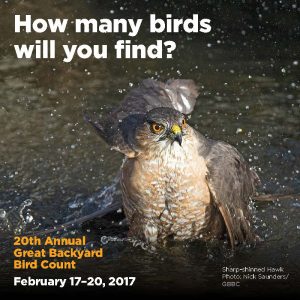Caleb Putnam, Michigan Bird Conservation Coordinator for Audubon Great Lakes and Michigan Department of Natural Resources, and member of Team eBird Michigan, provides the following excellent information regarding eBird data entry during the Great Backyard Bird Count.
 This year the Great Backyard Bird Count (GBBC) will be held on February 17-20. Like with the Christmas Bird Count, this is an opportunity to welcome hundreds of new users to eBird and birding. But as such, this comes with an increased need for monitoring data quality on the part of eBird reviewers. In preparation, we have made some significant changes to the eBird filters during a 10-day period spanning February 12-21. We wanted to provide the following heads up so users know what to expect, and to provide all eBird users with a timely update on proper eBird protocol and how to properly enter your eBird GBBC data. All GBBC data are now entered into eBird.
This year the Great Backyard Bird Count (GBBC) will be held on February 17-20. Like with the Christmas Bird Count, this is an opportunity to welcome hundreds of new users to eBird and birding. But as such, this comes with an increased need for monitoring data quality on the part of eBird reviewers. In preparation, we have made some significant changes to the eBird filters during a 10-day period spanning February 12-21. We wanted to provide the following heads up so users know what to expect, and to provide all eBird users with a timely update on proper eBird protocol and how to properly enter your eBird GBBC data. All GBBC data are now entered into eBird.
1) Please avoid cumulative counts during feeder watching – ONLY report the maximum number of individuals of each species seen at one time. To help us catch improper cumulative totals, we have tightened the filters for chickadees, titmouses, and Downy Woodpeckers, to much lower levels than normal. When these flag, please write your counting protocol in the species comments box, letting us know that you know not to double count and giving us an idea how you arrived at your numbers.
2) Please make sure to create a unique eBird checklist for each birding session, ie. not lumping separate sessions together into one longer count. For example, if you watch the feeder for 15 minutes at 9AM, leave to do laundry for 45minutes, and return again for 15 minutes at 10AM, these should be eBirded as two separate stationary (or traveling if you’re walking the yard) checklists, not one 1.25 hour count. If you must lump them, the resulting checklist must be eBirded as an incidental count.
3) Here is a list of species which will be flagged at 0 individuals during GBBC, which normally aren’t (in some or all of Michigan):
Wood Duck
Northern Goshawk (north)
Red-shouldered Hawk
Snowy Owl
Red-headed Woodpecker
Northern Flicker
Merlin
Peregrine Falcon
Carolina Wren (LP)
Winter Wren (south)
Bohemian Waxwing (north)
Hermit Thrush (south)
Lapland Longspur (south)
White-throated Sparrow (south)
White-crowned Sparrow (south)
Fox Sparrow (south)
Song Sparrow (LP)
Brown-headed Cowbird (south)
Purple Finch
White-winged Crossbill
Red Crossbill
These are species which are commonly misidentified, so we will be checking them all, to make sure the maps for these species remain clean. Please be patient with this process over the next 10 days. If you do enter anything that flags, all we ask is that you write in a description of the field marks observed, a description of the method you used to arrive at your high count, and it always helps to acknowledge that you understand the GBBC protocol. If you don’t do this, we will likely send you an email to ask. This is the busiest period of the year for eBird reviewers, so your cooperation is greatly appreciated! Most of the time, even a few words or a single sentence is all that is needed for us to validate a record. For example, Red-bellied Woodpeckers are very commonly entered as Red-headed Woodpeckers. If you report a Red-headed, even a basic description such as “all-red head with a large white square on the wings” is enough for us to recognize that the observation isn’t a typo or mistaken Red-bellied Woodpecker. If you have a flagging bird you’re continually eBirding, document it the first time, then just type in “continuing” each subsequent time.
A great deal of additional information on the GBBC is available here: http://gbbc.birdcount.org/. And we also have a detailed blogpost on eBird protocol here: https://teamebirdmichigan.wordpress.com/2015/10/25/proper-ebird-protocol/.
We really appreciate everyone’s cooperation and patience as we reviewers do our best to keep Michigan’s eBird maps and dataset as clean as possible during the GBBC period. Please email your reviewer with any additional questions.
